Abstract
The present study explores the innovative application of virtual reality (VR) in conducting the Radial Arm Maze (RAM) task, a performance-based test traditionally utilized for assessing spatial memory. This study aimed to develop a gamified version of the RAM implemented in immersive VR and investigate the interaction between the sense of presence, movement features, and performance within the RAM. We developed software supporting a head-mounted display (HMD), addressing prior limitations in the scientific literature concerning user interaction, data collection accuracy, operational flexibility, and immersion level. This study involved a sample of healthy young adults who engaged with the immersive VR version of the RAM, examining the influence of VR experience variables (sense of presence, motion sickness, and usability) on RAM performance. Notably, it also introduced the collection and analysis of movement features within the VR environment to ascertain their impact on performance outcomes and their relationship with VR experience variables. The VR application developed is notable for its user-friendliness, adaptability, and integration capability with physiological monitoring devices, marking a significant advance in utilizing VR for cognitive assessments. Findings from our study underscore the importance of VR experience factors in RAM performance, highlighting how a heightened sense of presence can predict better performance, thereby emphasizing engagement and immersion as crucial for task success in VR settings. Additionally, this study revealed how movement parameters within the VR environment, specifically speed and directness, significantly influence RAM performance, offering new insights into optimizing VR experiences for enhanced task performance.
1. Introduction
Spatial navigation is an essential cognitive skill, encompassing the ability to navigate through, understand, and remember the spatial relationships in our environment [1]. Commonly based on spatial navigation tasks, spatial navigation studies are crucial in developing interventions for individuals with impaired spatial awareness and navigation, such as Alzheimer’s disease or stroke rehabilitation patients [2]. Navigation tasks in virtual environments are crucial in assessing and enhancing an individual’s ability to navigate space. Often structured as performance-based tests, these tasks find extensive utility across various domains such as research, rehabilitation, and training. Among various navigation tasks suitable for virtual environments, the Radial Arm Maze (RAM) task is one of the most used performance-based tests to assess spatial abilities [3]. The RAM task, developed by Olton and Samuelson (1976) [4] to assess spatial memory in rodents, is a performance-based test also used in several studies on children [5] and adults [6,7]. The RAM plays a crucial role in assessing spatial learning and memory. For instance, it has been used to examine the impact of aging, neurodegenerative diseases, and pharmacological treatments on spatial learning and memory capabilities [8,9]. Implementing and running a physical version of the RAM requires plenty of space, and performance could be affected by external landmarks, such as the Sun or the clouds, potentially adding a bias to the experiment results. A recent review emphasizes the limitations of the real-world version of the RAM and the growing use of the RAM task in virtual environments to study spatial abilities [10]. Also, other recent tools such as the VIENNA VR-based navigation battery demonstrate the increasing validity of VR in assessing spatial deficits, even in aging populations [11].
Given the advantages of developing the RAM in virtual environments, most studies utilize non-immersive virtual reality (VR) [3,12], which allows easy modification of scenarios and the ability to present different perspectives to the subject. However, non-immersive VR, akin to video viewing, lacks the sense of being part of the environment, which is crucial for realistic spatial exploration and can affect the assessment of spatial abilities [13]. Although the characteristics of VR technology can deliver different degrees of immersion in a virtual environment, the sense of presence (SoP) experienced by participants results from a complex interaction between human factors, contextual factors, and the virtual environment, playing an important role in the VR experience. The scientific literature makes no definitive claims about the relationship between the SoP and performance [14]. Several studies have reported a positive effect [15], moderation effect [16], or null effect [17] of SoP on performance in a variety of virtual environments and tasks, showing inconsistent findings. While the influence of SoP on performance remains an open question, there is no scientific evidence regarding the influence that SoP may exert on movement features within the virtual environment. Understanding this relationship could be crucial because movement and navigation are key components of many VR applications, from training simulations to therapeutic interventions. Analyzing the interaction of SoP with movement features could enhance our understanding of the intricate effects of SoP in VR performance.
In light of the above, in this study, we propose a version of the RAM implemented in immersive VR, aiming to overcome the limitations in the literature regarding user interaction, data collection accuracy, flexibility, and immersion in existing RAM applications. Additionally, we tested the influence of the VR experience variables (i.e., SoP, motion sickness, and usability) on the performance of the RAM. In addition, we collected movement features to investigate how the quality of movements (i.e., directness and speed) in the VR environment can be correlated with RAM performance and VR experience variables.
Statement of Significance
- Problem: Assessing spatial memory through virtual reality tasks.
- What is Already Known: The Radial Arm Maze (RAM) task is one of the most used performance-based tests to assess spatial abilities; studies have shown the limitations of the real-world version of the RAM and the growing use of the RAM task in virtual environments to study spatial abilities. This shift is supported by recent reviews demonstrating the value of immersive and desktop VR for assessing spatial cognition [18].
- What This Paper Adds: We propose a version of the RAM implemented in immersive VR, aiming to overcome the limitations in the literature regarding user interaction, data collection accuracy, flexibility, and immersion in existing virtual RAM applications; we investigate how participants’ sense of presence and movement features (i.e., the way they explore the RAM) correlate with the RAM task performance (i.e., number of errors).
2. Methods
2.1. VR RAM Application
We developed a VR version of the RAM (see Figure 1) that can run on any consumer-level desktop computer equipped with a VR headset, even in a small physical space. The application runs smoothly at 90 FPS on an Intel i7 3.7 GHz gaming desktop computer with 16 GB RAM and an NVIDIA GeForce GTX1070 8 GB graphic card. The Oculus Quest 2 head-mounted display allows users a fully immersive virtual experience. The software was developed in Unity3D (version 2020) a game development platform that provides native VR support on the Windows platform. Users move in the RAM through the Oculus Quest 2 controllers. They use them to move forward and backward, while the left and right rotation is performed by physically rotating on the swiveling office chair they are sitting on. As the participants are wearing a VR head-mounted display, while they rotate their body on the swivel chair, the VR headset automatically tracks head rotation and, consequently, counter-rotates the view, as it would do if the participants were standing instead of sitting. So, there was no need to add any external tracking system to maintain the sync between the chair and VR-view rotation.
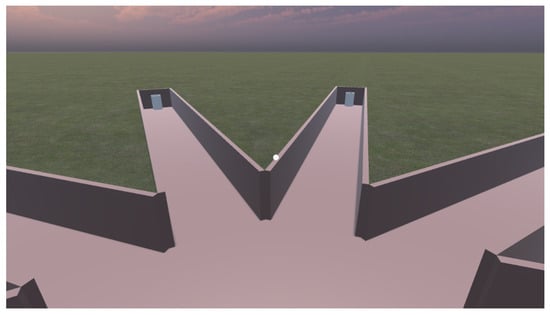
Figure 1.
The VR version of the RAM in Unity3D.
The application provides two views, one for the operator and another for the patient. The VR RAM consists of a round central platform (3 m diameter) with eight arms (1 m wide; in the adult version, each arm is 6 m long, 3 for children; and arm walls can vary between 0.5 and 2 m with a step of half a meter) radiating like the spokes of a wheel. A blue plastic bucket (18 cm wide, 10 cm tall) containing the reward (a coin) was placed at the end of each arm. The RAM is placed in a large garden; participants see clouds above their heads and hear birds chirping (see Figure 1). The application records several parameters according to RAM administration. However, given the aims of the present study, we analyzed only the errors made during the task.
2.2. Participants
Sixteen university students took part in the experiment. This study was approved by the Ethical Committee (Department of Psychology of Developmental and Socialization Processes at Sapienza University of Rome). All methods followed relevant guidelines and regulations per the Declaration of Helsinki. Written informed consent was obtained from participants, which specified all VR-related risks. Participants were asked if they had ever experienced any symptoms of motion sickness in past virtual reality experiences or other visual devices (i.e., video games).
2.3. Procedure
Participants were positioned in a swiveling office chair that facilitated a full rotation of 360 degrees. They wore the Oculus Quest 2 head-mounted display (HMD) and completed a training session with the VR system. They were asked to navigate and retrieve objects from the ground using the VR controllers within the virtual environment. After the VR training, they were instructed to perform four trials within the virtual system: two free-choice trials and two forced-choice trials. In the free-choice version, the participant must take all the rewards and know that the arms are rewarded only once. To solve the task without errors, the participant must use mnesic and mapping abilities and proficient explorative strategies. The forced-choice paradigm has two phases per trial. In the first phase, participants must collect only four rewards, while the remaining rewards are inaccessible. In the second phase, they must collect the rewards of the four arms that they did not visit in the first phase. Success depends on remembering the arms visited in the first phase rather than following a particular search pattern, which emphasizes the need for working memory. The errors (sequence of wrong entries) were collected. Once participants completed all the trials, the following questionnaires were administered: presence questionnaire [19], cybersickness symptoms questionnaire [20], System Usability Scale (SUS) [21], and attitude toward VR task [22].
2.4. Movement Features
We compute two movement features, namely speed and directness, from the participants’ 2D trajectory (as participants could neither “fly” nor “dig” while exploring the RAM, and the surface is perfectly flat so that we can ignore the third dimension), recorded by the application at a frame rate of 10 times per second during the experiment trials. These features are well-established tools commonly used in Human–Computer Interaction to determine the expressiveness of a user’s movements, i.e., what the user aims to communicate (e.g., their emotional state) through non-verbal behavior [23]. Also, they are reported in the psychological literature as indicators of certainty/fluency (speed of movement [24,25]) and accuracy/quality of movement planning (directness of movement [26,27]). The feature extraction process is as follows:
- We filter out the 2D trajectories to remove noise through a 2 Hz low-pass Butterworth filter [28], which is a well-established human motion pre-processing step [29].
- To remove artifacts, e.g., signal spikes, and obtain the signal’s 1st derivative, we apply a 3rd-order Savitzky–Golay filter on time windows of about 1.5 s [30]; these filter settings are used in the literature to obtain smoothed derivatives of human movement signals [31].
- We compute the speed feature by considering the magnitude (i.e., Euclidean norm) of the position’s 1st derivative.
- We compute directness, which, given a 2D trajectory of 2D points T, is defined as the ratio between A and B, where A is the distance between the 1st and last point in T, and B is the length of T [23]; that is, the more direct T is, the closer to 1 directness becomes, while the more non-straight T is, the closer to 0 directness becomes.
Regarding the filtering steps, the reported parameters are based on the literature [23,29,31] and empirical tests, which showed that the chosen values allow us to keep the signal characteristics (e.g., peaks and valleys) for both position and speed data by removing noise and artifacts.
2.5. Analysis
The data analysis was conducted using Jamovi software (version 2, https://www.jamovi.org). Descriptive analyses of the VR questionnaires were performed. Three trained observers assessed RAM scoring in VR to identify any disparities between automated and human scoring. The manual scoring by the three trained observers was in complete agreement with the automated scoring produced by the application. As no discrepancies were observed, the automated scores were used for all subsequent analyses. We conducted the Shapiro–Wilk test for normality. Pearson correlations were performed to compute the bivariate correlations between the VR questionnaires. Since some variables were not normally distributed, we employed Robust Linear Mixed Models (RLMMs) to analyze our data. This choice was motivated by the structure of our dataset, which included repeated measures from subjects over time and required the modeling of both fixed and random effects to capture the underlying relationships accurately:
- Model 1: To assess the impact of time, directness, speed, sense of presence, motion sickness, and usability on the error;
- Model 2: To assess the impact of time, error, sense of presence, motion sickness, and usability on the directness.
As random effects, we had intercepts for subjects for each model to test individual differences. Each model was performed separately for free-choice (i.e., trials 1 and 2) and forced-choice (i.e., trials 3 and 4) paradigms. We used R (version 4, https://www.r-project.org) and the robustllm package [32] to perform the analysis.
Finally, we conducted a mediation analysis using robust linear mixed-effects models (rlmer and robustlmm packages) to examine indirect effects of SoP on movement features. The analysis was conducted separately for the forced-choice condition. Presence was modeled as the independent variable (X), speed as the mediator (M), and directness as the dependent variable (Y). Random intercepts were included to account for within-subject variability across repeated measures. Indirect effects were computed as the product of the fixed-effect coefficients for path a () and path b ().
3. Results
3.1. Characteristics of the Sample
On average, participants were years old (; ). The sample comprised 62% males.
3.2. Correlation Among VR Variables
The correlation matrix showed a significant positive correlation between attitude toward VR and sense of presence (r = 0.716, p < 0.01) and a negative correlation between attitude toward VR and motion sickness (, p < 0.05). No other relationships between the variables measuring experience in VR appear to be statistically significant. All the correlations are reported in Table 1.

Table 1.
Correlations among VR variables (Pres, Sense of Presence; MS, Motion Sickness; AT, Attitude Toward VR; SUS, System Usability Scale).
3.3. Model 1
3.3.1. Free-Choice Paradigm
The errors in the RAM were significantly predicted by directness (, , , ) and speed (, , , ). None of the other fixed effects (i.e., time, motion sickness, usability, and sense of presence) significantly predicted the errors in the RAM. Figure 2 reports the significant negative effect of directness on errors in the RAM, suggesting an inverse relationship. Figure 3 reports the significant positive effect of speed on errors in the RAM.
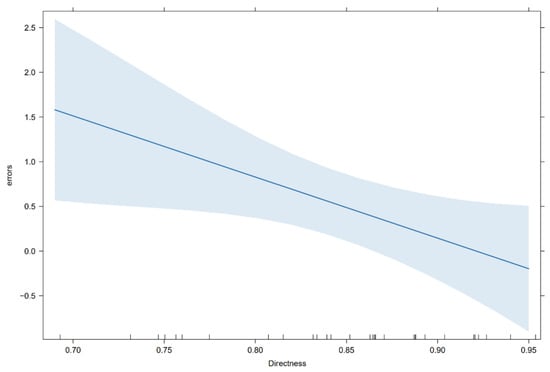
Figure 2.
Graph showing the significant negative effect of directness on errors.
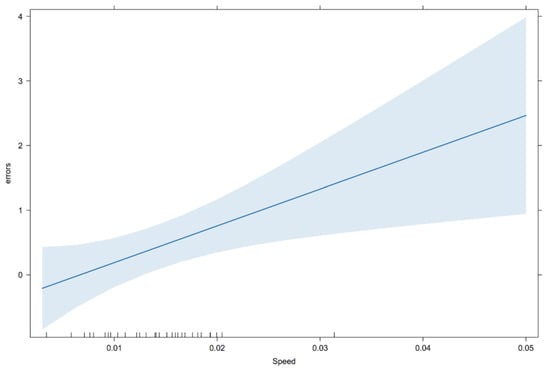
Figure 3.
Graphs showing the significant positive effect of speed on errors.
For the random effects, the results showed that the variance is 0, indicating no variability in the intercept across different individuals. This suggests that individual differences do not significantly contribute to error variability.
3.3.2. Forced-Choice Paradigm
The errors in the RAM were significantly predicted by time (, , , ) and presence (, , , ). None of the other fixed effects (i.e., directness, speed, motion sickness, and usability) significantly predicted the errors in the RAM. Figure 4 reports the significant negative effect of time on errors in the RAM, suggesting an inverse relationship. Figure 5 reports the significant negative effect of presence on errors in the RAM.
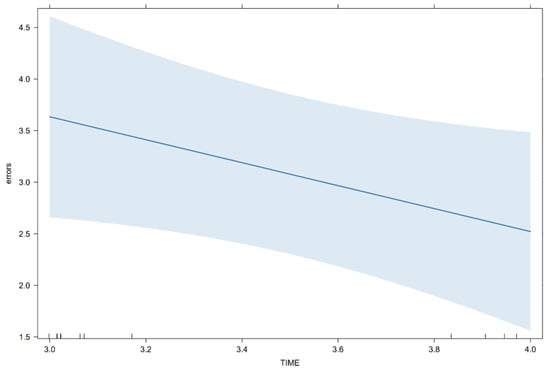
Figure 4.
Graphs showing the significant negative effect of time on errors.
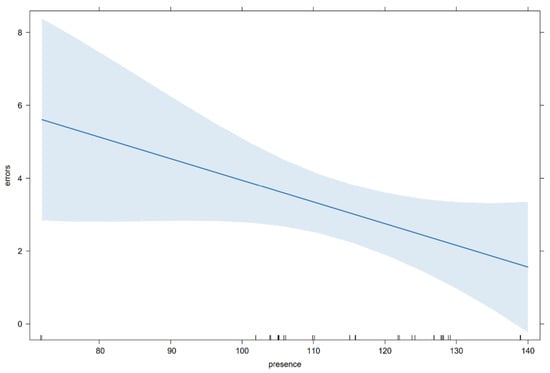
Figure 5.
Graphs showing the significant negative effect of presence on errors.
For the random effects, the results showed a variance of and a standard deviation of for the random intercepts associated with individuals, which is significant, indicating notable variability in the baseline level of “errors” across different individuals.
3.4. Model 2
3.4.1. Free-Choice Paradigm
Directness in the RAM was significantly predicted by errors (, , , ). None of the other fixed effects (i.e., time, motion sickness, usability, and presence) significantly predicted the directness in the RAM. Figure 6 reports the significant negative effect of errors on directness in the RAM, suggesting an inverse relationship.
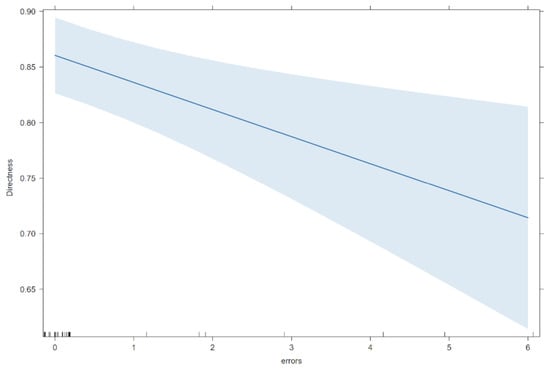
Figure 6.
Graphs showing the significant negative effect of errors on directness.
The random effect’s variance was , and the standard deviation was for the random intercepts associated with individuals. This effect was relatively small, indicating only minor variability in the baseline levels of directness across different individuals.
3.4.2. Forced-Choice Paradigm
Directness in the RAM was significantly predicted by time (, , , ) and presence (, , , ). None of the other fixed effects (i.e., errors, motion sickness, and usability) significantly predicted the directness in the RAM. Figure 7 reports the significant negative effect of time on directness in the RAM, suggesting an inverse relationship. Figure 8 reports the significant positive effect of presence on directness in the RAM.
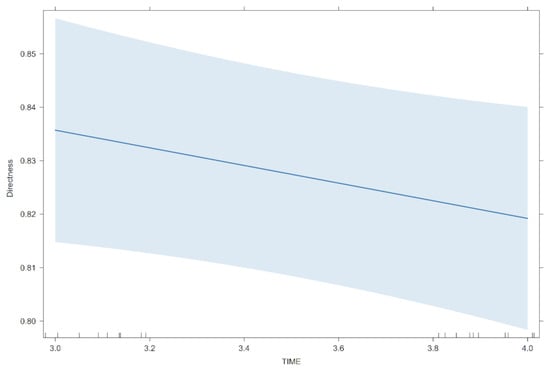
Figure 7.
Graphs showing the significant negative effect of time on directness.
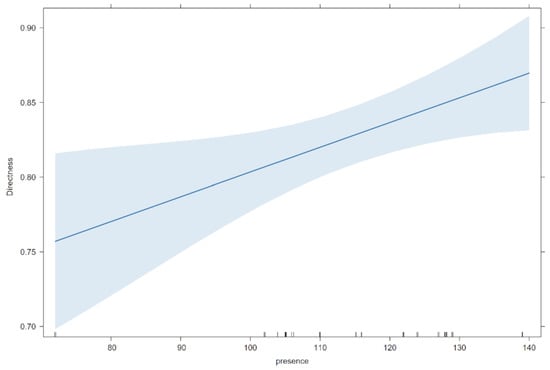
Figure 8.
Graphs showing the significant positive effect of presence on directness.
For the random effects, the results showed a variance of and a standard deviation of for the random intercepts associated with individuals. This effect was relatively small, indicating only minor variability in the baseline levels of directness across different individuals.
3.5. Mediation Effect of SoP
To explore whether sense of presence (SoP) influenced movement features through indirect mechanisms, we conducted a longitudinal mediation analysis using robust linear mixed models (rlmer) within the forced-choice condition. Specifically, we tested whether speed acted as a mediator of the effect of SoP (indexed via the presence composite score) on directness. In Model 1, SoP did not significantly predict speed (, , ), suggesting a negligible direct influence of SoP on movement velocity. In Model 2, speed showed a marginally significant effect on directness (, , ), while the direct effect of SoP on directness was statistically significant (, , ). The estimated indirect effect of SoP on directness via speed was minimal and non-significant (indirect effect: ). These findings do not support a mediation model but instead point to a direct relationship between sense of presence and movement directness in the dorced-choice condition. This suggests that SoP contributes to motor behavior adaptation independently of speed modulation.
4. Discussion
4.1. Sense of Presence Within RAM in VR
Although the role of SoP in affecting performance in VR tasks is still debated, our study provides insightful data on how SoP impacts task performance in VR settings. RLMM analysis revealed a significant relationship between SoP and task performance in the forced-choice trials, suggesting that a higher SoP determined fewer errors, indicating enhanced cognitive engagement and spatial awareness among participants. Additionally, the analysis of directness in the RAM under the forced-choice paradigm revealed that a heightened SoP within the VR environment may enhance the users’ ability to navigate purposefully and make strategic decisions, reflecting a more immersive and focused interaction with the virtual space. These results showed, for the first time in the scientific literature on the RAM, that SoP could play a crucial role in predicting VR performance. According to other VR tasks, this study’s findings support that a higher SoP in VR can lead to better task performance, especially in memory-related tasks [33]. In the forced-choice paradigm, spatial short-term memory processes are more prominently involved than in the free-choice paradigm. The free-choice paradigm is hypothesized to engage flexible exploratory behaviors supported by hippocampal-based mapping systems, whereas the forced-choice paradigm likely recruits caudate- and prefrontal-dependent working memory circuits for guiding navigation decisions [3]. When participants feel more present in the VR environment, they perform better in tasks that require memory processing, such as recalling paths or strategies in the maze.
In contrast, the free-choice paradigm relies less on spatial short-term memory processes and more on mnesic components and procedural strategies [3]. The difference in the role of SoP between these two paradigms highlights how its impact on performance depends on the nature of the task. According to previous studies [14] in memory tasks (e.g., forced-choice), SoP enhances performance by improving cognitive engagement and awareness. In contrast, in more exploratory tasks (e.g., free-choice), the impact might be less pronounced, as these tasks rely less on memory. Indeed, our findings indicate that SoP does not significantly predict errors and directness in the free-choice paradigm of the RAM. Finally, motion sickness showed no relationship with errors and directness. The low level of motion sickness among all participants could explain the lack of relationship with these outcomes. Our study highlights the nuanced impact of SoP, particularly in task-oriented contexts. The findings suggest that the SoP influence varies across task paradigms and performance metrics. This understanding is crucial for designing and optimizing VR environments for various applications, from cognitive research to clinical interventions. SoP may support performance through enhanced embodiment, self-location, and agency processes, which strengthen spatial memory encoding and retrieval in immersive VR, particularly in the forced-choice tasks that prominently involve spatial memory.
4.2. RAM Score and Movement Within the Virtual Environment
For the first time, our study has delved into analyzing movement parameters and their influence on performance in the RAM. Exploring movement dynamics in VR environments provides new perspectives on cognitive performance and navigational strategies. In the free-choice paradigm of the RAM, the relationship between task performance and various factors was particularly insightful. The errors made in the RAM were found to be significantly influenced by directness, suggesting that more directed or purposeful navigation led to fewer errors. This indicates that participants’ performance improved when they navigated the maze with a clear strategy or goal. Notably, these effects were absent in the forced-choice paradigm of the RAM. As mentioned above for the SoP, this discrepancy might be attributed to the differing cognitive demands of the two paradigms. The free-choice paradigm likely engages more exploratory mechanisms, in contrast to the forced-choice paradigm, which may hinge more on working memory processes than on exploration, reducing movement parameters’ influence. Furthermore, the analysis indicated that the error number significantly influences directness in the RAM. This finding suggests a reciprocal relationship where increased errors during the trial may lead to participants’ uncertainties, making movement less smooth and direct. Additionally, time negatively affected both directness and errors in the forced-choice paradigm. Given that the forced-choice paradigm was carried out in the last two trials, this result probably suggests a learning effect of the trial regarding the errors made in the RAM and a fatigue effect regarding directness during the trials. Our preliminary study provides insights into how movement parameters in VR, specifically speed and directness, significantly affect cognitive performance in a spatial navigation task. Previous research in VR has primarily focused on aspects like presence, immersion, and the technical features of VR systems [34]. These findings have profound implications for understanding cognitive processes in VR environments. They can inform the design of VR-based cognitive assessments and therapies, especially those focusing on spatial memory and navigation. Additionally, these findings align with recent systematic reviews emphasizing VR’s ecological validity and its relevance for cognitive assessment and training [35].
5. Conclusions
The present study represents a significant advancement in utilizing VR for cognitive assessments, addressing limitations in the current scientific literature. A novel aspect of this study is the analysis of movement data within the VR environment and its relationship with SoP and RAM performance. This approach provides new insights into intricate relationships between movement, VR experience variables, and performance in VR spatial tasks. Our study comprised a sample of 16 healthy young adults, limiting the findings’ generalizability. The specific characteristics of young adults may not accurately represent other age groups or clinical populations with different cognitive and physical attributes. This limitation is significant, especially when considering the application of VR in diverse populations. Future work will extend the VR RAM to clinical populations, such as individuals with mild cognitive impairment, Alzheimer’s disease, or stroke survivors, where spatial navigation deficits have substantial clinical relevance. Additionally, we acknowledge that the absence of a non-immersive or desktop control group limits our ability to isolate the unique contribution of immersive VR. Future studies should include such a condition to quantify the added benefit of immersion on navigation performance. In conclusion, this preliminary study represents a significant step forward in applying VR in cognitive science. It demonstrates the potential of VR to innovate traditional cognitive assessment methods and opens new research directions by integrating movement analysis into cognitive performance evaluation. Future studies should aim to address the identified limitations, exploring broader participant demographics and incorporating additional physiological and behavioral measures to fully harness the potential of VR in cognitive research and clinical applications.
Author Contributions
Methodology, T.P., A.C., L.M., M.M., N.P., E.V., F.A. and F.L.; Validation, T.P., A.C., L.M., M.M., N.P., E.V., F.A. and F.L.; Investigation, T.P., A.C., L.M., M.M., N.P., E.V., F.A. and F.L. All authors have read and agreed to the published version of the manuscript.
Funding
This research received no external funding.
Institutional Review Board Statement
This study was approved by the Ethical Committee for Psychological Research of the Humanities Department of the University of Naples Federico II (n.prot.14/2023).
Data Availability Statement
Data can be made available by authors on a reasonable request.
Conflicts of Interest
The authors declare no conflicts of interest.
References
- Gazova, I.; Vlcek, K.; Laczó, J.; Nedelska, Z.; Hyncicova, E.; Mokrisova, I.; Sheardova, K.; Hort, J. Spatial navigation—A unique window into physiological and pathological aging. Front. Aging Neurosci. 2012, 4, 16. [Google Scholar] [CrossRef]
- Giovagnoli, G.; Vicari, S.; Tomassetti, S.; Menghini, D. The role of visual-spatial abilities in dyslexia: Age differences in children’s reading? Front. Psychol. 2016, 7, 1997. [Google Scholar] [CrossRef]
- Iaria, G.; Petrides, M.; Dagher, A.; Pike, B.; Bohbot, V.D. Cognitive strategies dependent on the hippocampus and caudate nucleus in human navigation: Variability and change with practice. J. Neurosci. 2003, 23, 5945–5952. [Google Scholar] [CrossRef] [PubMed]
- Olton, D.; Samuelson, R. Remembrance of places passed: Spatial memory in rats. J. Exp. Psychol. Anim. Behav. Process. 1976, 2, 97–116. [Google Scholar] [CrossRef]
- Bertholet, L.; Escobar, M.T.; Depré, M.; Chavan, C.F.; Giuliani, F.; Gisquet-Verrier, P.; Preissmann, D.; Schenk, F. Spatial radial maze procedures and setups to dissociate local and distal relational spatial frameworks in humans. J. Neurosci. Methods 2015, 253, 126–141. [Google Scholar] [CrossRef] [PubMed]
- Glassman, R.B.; Leniek, K.M.; Haegerich, T.M. Human working memory capacity is 7±2 in a radial maze with distracting interruption: Possible implication for neural mechanisms of declarative and implicit long-term memory. Brain Res. Bull. 1998, 47, 249–256. [Google Scholar] [CrossRef] [PubMed]
- O’connor, R.C.; Glassman, R.B. Human performance with a seventeen-arm radial maze analog. Brain Res. Bull. 1993, 30, 189–191. [Google Scholar] [CrossRef]
- Lee, J.Y.; Kho, S.; Yoo, H.B.; Park, S.; Choi, J.S.; Kwon, J.S.; Cha, K.R.; Jung, H.Y. Spatial memory impairments in amnestic mild cognitive impairment in a virtual radial arm maze. Neuropsychiatr. Dis. Treat. 2014, 10, 653–660. [Google Scholar] [CrossRef]
- Levin, E.D. Psychopharmacological effects in the radial-arm maze. Neurosci. Biobehav. Rev. 1988, 12, 169–175. [Google Scholar] [CrossRef]
- Palombi, T.; Mandolesi, L.; Alivernini, F.; Chirico, A.; Lucidi, F. Application of real and virtual radial arm maze task in human. Brain Sci. 2022, 12, 468. [Google Scholar] [CrossRef]
- Rekers, S.; Finke, C. Translating spatial navigation evaluation from experimental to clinical settings: The virtual environments navigation assessment (VIENNA). Behav. Res. Methods 2024, 56, 2033–2048. [Google Scholar] [CrossRef] [PubMed]
- Patel, S.A.; Frick, K.M.; Newhouse, P.A.; Astur, R.S. Estradiol effects on spatial memory in women. Behav. Brain Res. 2022, 417, 113592. [Google Scholar] [CrossRef] [PubMed]
- García-López, H.; Obrero-Gaitán, E.; Castro-Sánchez, A.M.; Lara-Palomo, I.C.; Nieto-Escamez, F.A.; Cortés-Pérez, I. Non-immersive virtual reality to improve balance and reduce risk of falls in people diagnosed with parkinson’s disease: A systematic review. Brain Sci. 2021, 11, 1435. [Google Scholar] [CrossRef] [PubMed]
- Maneuvrier, A.; Decker, L.M.; Ceyte, H.; Fleury, P.; Renaud, P. Presence promotes performance on a virtual spatial cognition task: Impact of human factors on virtual reality assessment. Front. Virtual Real. 2020, 1, 571713. [Google Scholar] [CrossRef]
- Cooper, N.; Milella, F.; Pinto, C.; Cant, I.; White, M.; Meyer, G. The effects of substitute multisensory feedback on task performance and the sense of presence in a virtual reality environment. PLos ONE 2018, 13, e0191846. [Google Scholar] [CrossRef]
- Palombi, T.; Galli, F.; Giancamilli, F.; D’Amico, M.; Alivernini, F.; Gallo, L.; Neroni, P.; Predazzi, M.; De Pietro, G.; Lucidi, F.; et al. The role of sense of presence in expressing cognitive abilities in a virtual reality task: An initial validation study. Sci. Rep. 2023, 13, 13396. [Google Scholar] [CrossRef]
- Voinescu, A.; Petrini, K.; Stanton Fraser, D.; Lazarovicz, R.A.; Papavă, I.; Fodor, L.A.; David, D. The effectiveness of a virtual reality attention task to predict depression and anxiety in comparison with current clinical measures. Virtual Real. 2023, 27, 119–140. [Google Scholar] [CrossRef]
- Costanzo, M.G.; Smeriglio, R.; Di Nuovo, S. Virtual Reality for the assessment and treatment of cognitive impairment in the elderly: A scoping review. Life Span Disabil. 2023, 26, 293–328. [Google Scholar]
- Scheuchenpflug, R.; Ruspa, C.; Quattrocolo, S. Presence in virtual driving simulators. In Human Factors in the Age of Virtual Reality; Shaker Publishing: Maastricht, The Netherlands, 2003; pp. 143–148. [Google Scholar]
- Solimini, A.G.; Mannocci, A.; Di Thiene, D. A pilot application of a questionnaire to evaluate visually induced motion. Ital. J. Public Health 2011, 8, 197–204. [Google Scholar]
- Brooke, J. SUS-A quick and dirty usability scale. Usability Eval. Ind. 1996, 189, 4–7. [Google Scholar]
- Ajzen, I. The theory of planned behavior. Organ. Behav. Hum. Decis. Processes 1991, 50, 179–211. [Google Scholar] [CrossRef]
- Varni, G.; Mancini, M. Movement expressivity analysis: From theory to computation. In Modelling Human Motion: From Human Perception to Robot Design; Springer: Cham, Switherland, 2020; pp. 213–233. [Google Scholar]
- Beardsworth, C.E.; Whiteside, M.A.; Capstick, L.A.; Laker, P.R.; Langley, E.J.; Nathan, R.; Orchan, Y.; Toledo, S.; Van Horik, J.O.; Madden, J.R. Spatial cognitive ability is associated with transitory movement speed but not straightness during the early stages of exploration. R. Soc. Open Sci. 2021, 8, 201758. [Google Scholar] [CrossRef] [PubMed]
- Nguyen, N.D.; Tucker, M.A.; Stickgold, R.; Wamsley, E.J. Overnight sleep enhances hippocampus-dependent aspects of spatial memory. Sleep 2013, 36, 1051–1057. [Google Scholar] [CrossRef]
- Benhamou, S. How to reliably estimate the tortuosity of an animal’s path: Straightness, sinuosity, or fractal dimension? J. Theor. Biol. 2004, 229, 209–220. [Google Scholar] [CrossRef] [PubMed]
- Bae, C.; Montello, D.; Hegarty, M. Wayfinding in pairs: Comparing the planning and navigation performance of dyads and individuals in a real-world environment. Cogn. Res. Princ. Implic. 2024, 9, 40. [Google Scholar] [CrossRef]
- Selesnick, I.W.; Burrus, C.S. Generalized digital Butterworth filter design. IEEE Trans. Signal Process. 1998, 46, 1688–1694. [Google Scholar] [CrossRef]
- Dill, S.; Ahmadi, A.; Grimmer, M.; Haufe, D.; Rohr, M.; Zhao, Y.; Sharbafi, M.; Antink, C.H. Accuracy Evaluation of 3D Pose Reconstruction Algorithms Through Stereo Camera Information Fusion for Physical Exercises with MediaPipe Pose. Sensors 2024, 24, 7772. [Google Scholar] [CrossRef]
- Savitzky, A.; Golay, M.J. Smoothing and differentiation of data by simplified least squares procedures. Anal. Chem. 1964, 36, 1627–1639. [Google Scholar] [CrossRef]
- Li, L.L.; Zhang, Y.P.; Cao, G.Z.; Li, W.Z. Human-in-the-Loop Trajectory Optimization Based on sEMG Biofeedback for Lower-Limb Exoskeleton. Sensors 2024, 24, 5684. [Google Scholar] [CrossRef] [PubMed]
- Koller, M. robustlmm: An R package for robust estimation of linear mixed-effects models. J. Stat. Softw. 2016, 75, 1–24. [Google Scholar] [CrossRef]
- Cadet, L.B.; Reynaud, E.; Chainay, H. Memory for a virtual reality experience in children and adults according to image quality, emotion, and sense of presence. Virtual Real. 2022, 26, 55–75. [Google Scholar] [CrossRef] [PubMed]
- Slater, M.; Sanchez-Vives, M.V. Enhancing our lives with immersive virtual reality. Front. Robot. AI 2016, 3, 74. [Google Scholar] [CrossRef]
- Mancuso, V.; Sarcinella, E.D.; Bruni, F.; Arlati, S.; Di Santo, S.G.; Cavallo, M.; Cipresso, P.; Pedroli, E. Systematic review of memory assessment in virtual reality: Evaluating convergent and divergent validity with traditional neuropsychological measures. Front. Hum. Neurosci. 2024, 18, 1380575. [Google Scholar] [CrossRef] [PubMed]
Disclaimer/Publisher’s Note: The statements, opinions and data contained in all publications are solely those of the individual author(s) and contributor(s) and not of MDPI and/or the editor(s). MDPI and/or the editor(s) disclaim responsibility for any injury to people or property resulting from any ideas, methods, instructions or products referred to in the content. |
© 2025 by the authors. Licensee MDPI, Basel, Switzerland. This article is an open access article distributed under the terms and conditions of the Creative Commons Attribution (CC BY) license (https://creativecommons.org/licenses/by/4.0/).